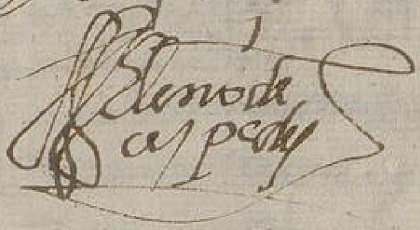|
Fernanda Fernández
Fernanda Fernández ( Zújar, Granada, 1755 – fl. 1792) was a Spanish nun, found to have an intersex trait following an investigation that Fernández initiated, and subsequently reclassified as male. Early life Fernanda Fernández took religious vows and became a nun at the age of eighteen in April 1774. In 1787, she told her confessor that she was developing male genitals, and asked to be removed from the nunnery. She was placed in isolation and became the central figure in an investigation conducted by the church. The archbishop, theologians and physicians were consulted. Departing the nunnery After an examination by a certified midwife, Fernández was certified as a male, and was forced to leave the nunnery on January 21, 1792. After more thorough examinations by physicians and midwives, Fernández was confirmed to have a small penis able to produce semen. Tomás Romay y Chacón, ''Historia Natural. Descripción de un hermafrodita: Diario del gobierno de La Habana'' (8 May 18 ... [...More Info...] [...Related Items...] OR: [Wikipedia] [Google] [Baidu] |
Brackets
A bracket is either of two tall fore- or back-facing punctuation marks commonly used to isolate a segment of text or data from its surroundings. Typically deployed in symmetric pairs, an individual bracket may be identified as a 'left' or 'right' bracket or, alternatively, an "opening bracket" or "closing bracket", respectively, depending on the Writing system#Directionality, directionality of the context. Specific forms of the mark include parentheses (also called "rounded brackets"), square brackets, curly brackets (also called 'braces'), and angle brackets (also called 'chevrons'), as well as various less common pairs of symbols. As well as signifying the overall class of punctuation, the word "bracket" is commonly used to refer to a specific form of bracket, which varies from region to region. In most English-speaking countries, an unqualified word "bracket" refers to the parenthesis (round bracket); in the United States, the square bracket. Glossary of mathematical sym ... [...More Info...] [...Related Items...] OR: [Wikipedia] [Google] [Baidu] |
Zújar
Zújar is a municipality located in the province of Granada, Spain. According to the 2005 census (INE INE, Ine or ine may refer to: Institutions * Institut für Nukleare Entsorgung, a German nuclear research center * Instituto Nacional de Estadística (other) * Instituto Nacional de Estatística (other) * Instituto Nacional Elec ...), the city has a population of 2746 inhabitants. References Municipalities in the Province of Granada {{Granada-geo-stub ... [...More Info...] [...Related Items...] OR: [Wikipedia] [Google] [Baidu] |
Province Of Granada
Granada is a province of southern Spain, in the eastern part of the autonomous community of Andalusia. It is bordered by the provinces of Albacete, Murcia, Almería, Jaén, Córdoba, Málaga, and the Mediterranean Sea (along the Costa Tropical). Its capital city is also called Granada. The province covers an area of . Its population was 921,338 , of whom about 30% live in the capital, and its average population density is . It contains 170 municipalities. Geography The tallest mountain in the Iberian Peninsula, Mulhacén, is located in Granada. It measures . The next highest mountains in the province are Veleta () and Alcazaba (). The river Genil, which rises in Granada, is one of the main tributaries of the Guadalquivir. Other important rivers include the Fardes, Monachil, Guadalfeo, Dílar, Ízbor, Verde and Darro. Granada shares the Sierra Nevada National Park (in the Sierra Nevada mountain range) with Almería province. Another important range is the Sierra de Baza. Th ... [...More Info...] [...Related Items...] OR: [Wikipedia] [Google] [Baidu] |
Intersex
Intersex people are individuals born with any of several sex characteristics including chromosome patterns, gonads, or genitals that, according to the Office of the United Nations High Commissioner for Human Rights, "do not fit typical binary notions of male or female bodies". Sex assignment at birth usually aligns with a child's anatomical sex and phenotype. The number of births with ambiguous genitals is in the range of 1:2000–1:4500 (0.022%–0.05%). Other conditions involve atypical chromosomes, gonads, or hormones. Some persons may be assigned and raised as a girl or boy but then identify with another gender later in life, while most continue to identify with their assigned sex. The number of births where the baby is intersex has been reported differently depending on who reports and which definition of intersex is used. Anne Fausto-Sterling and her co-authors suggest that the prevalence of "nondimorphic sexual development" might be as high as 1.7%. A study publish ... [...More Info...] [...Related Items...] OR: [Wikipedia] [Google] [Baidu] |
Intersex In History
Intersex, in humans and other animals, describes variations in sex characteristics including chromosomes, gonads, sex hormones, or genitals that, according to the UN Office of the High Commissioner for Human Rights, "do not fit typical binary notions of male or female bodies". Intersex people were historically termed hermaphrodites, "congenital eunuchs", or even congenitally "frigid". Such terms have fallen out of favor, now considered to be misleading and stigmatizing. Intersex people have been treated in different ways by different cultures. Whether or not they were socially tolerated or accepted by any particular culture, the existence of intersex people was known to many ancient and pre-modern cultures and legal systems, and numerous historical accounts exist. Ancient history Sumer A Sumerian creation myth from more than 4,000 years ago has Ninmah, a mother goddess, fashioning humanity out of clay. She boasts that she will determine the fate – good or bad – for all she fa ... [...More Info...] [...Related Items...] OR: [Wikipedia] [Google] [Baidu] |
Timeline Of Intersex History
The following is a timeline of intersex history. Timeline Pre-history * Sumerian creation myths, 4000 years ago, include the fashioning of a body with atypical sex characteristics. Antiquity * Hippocrates and Galen view sex as a spectrum between men and women, with "many shades in between, including hermaphrodites, a perfect balance of male and female". * Aristotle view hermaphrodites as having "doubled or superfluous genitals". 2nd century BCE *Callon of Epidaurus undergoes surgery on ambiguous genitalia, described by Diodorus Siculus. *Diophantus of Abae socially transitions and joins the army of Alexander Balas. 1st century BCE * Diodorus Siculus describes the god Hermaphroditus, "born of Hermes and Aphrodite", as having "a physical body which is a combination of that of a man and that of a woman"; he also reportes that such children born with such traits are seen as prodigies, able to foretell future events. 43 BCE – 17/18 CE * Ovid describes the birth of Hermaphr ... [...More Info...] [...Related Items...] OR: [Wikipedia] [Google] [Baidu] |
Eleno De Céspedes
Eleno de Céspedes, also known as Elena de Céspedes (1545 – ''died after'' 1588), was a Spanish surgeon who married a man and later a woman, and was tried by the Spanish Inquisition. Céspedes may have been an intersex and/or transgender person, or, if a woman, may have been a lesbian and/or the first female surgeon known in Spain and perhaps in Europe. Early life, first marriage, and travels Elena de Céspedes was born around 1545 in Alhama de Granada in Andalusia, Spain, to an enslaved black Muslim woman named Francisca de Medina and a free, Christian, Castilian peasant named Pero Hernández. Born into slavery, and branded on the cheeks as the mulatto offspring of a slave, Céspedes was freed as a child (and took the surname of a former owner's wife), and married a stonemason named Cristóbal Lombardo at age fifteen or sixteen. Within a few months, while Céspedes was pregnant with his child, Lombardo left because the two did not get along. According to Céspedes, Lombard ... [...More Info...] [...Related Items...] OR: [Wikipedia] [Google] [Baidu] |
1755 Births
Events January–March * January 23 (O. S. January 12, Tatiana Day, nowadays celebrated on January 25) – Moscow University is established. * February 13 – The kingdom of Mataram on Java is divided in two, creating the sultanate of Yogyakarta and the sunanate of Surakarta. * March 12 – A steam engine is used in the American colonies for the first time as New Jersey copper mine owner Arent Schuyler installs a Newcomen atmospheric engine to pump water out of a mineshaft. * March 22 – Britain's House of Commons votes in favor of £1,000,000 of appropriations to expand the British Army and Royal Navy operations in North America. * March 26 – General Edward Braddock and 1,600 British sailors and soldiers arrive at Alexandria, Virginia on transport ships that have sailed up the Potomac River. Braddock, sent to take command of the British forces against the French in North America, commandeers taverns and private homes to feed and house the t ... [...More Info...] [...Related Items...] OR: [Wikipedia] [Google] [Baidu] |
18th-century Spanish Nuns
The 18th century lasted from January 1, 1701 (Roman numerals, MDCCI) to December 31, 1800 (Roman numerals, MDCCC). During the 18th century, elements of Age of Enlightenment, Enlightenment thinking culminated in the American Revolution, American, French Revolution, French, and Haitian Revolution, Haitian Revolutions. During the century, History of slavery, slave trading and human trafficking expanded across the shores of the Atlantic Ocean, Atlantic, while declining in Russian Empire, Russia, Qing dynasty, China, and Joseon, Korea. Revolutions began to challenge the legitimacy of monarchical and aristocratic power structures, including the structures and beliefs that Proslavery, supported slavery. The Industrial Revolution began during mid-century, leading to radical changes in Society, human society and the Natural environment, environment. Western historians have occasionally defined the 18th century otherwise for the purposes of their work. For example, the "short" 18th cen ... [...More Info...] [...Related Items...] OR: [Wikipedia] [Google] [Baidu] |
18th-century LGBT People
The 18th century lasted from January 1, 1701 ( MDCCI) to December 31, 1800 ( MDCCC). During the 18th century, elements of Enlightenment thinking culminated in the American, French, and Haitian Revolutions. During the century, slave trading and human trafficking expanded across the shores of the Atlantic, while declining in Russia, China, and Korea. Revolutions began to challenge the legitimacy of monarchical and aristocratic power structures, including the structures and beliefs that supported slavery. The Industrial Revolution began during mid-century, leading to radical changes in human society and the environment. Western historians have occasionally defined the 18th century otherwise for the purposes of their work. For example, the "short" 18th century may be defined as 1715–1789, denoting the period of time between the death of Louis XIV of France and the start of the French Revolution, with an emphasis on directly interconnected events. To historians who expan ... [...More Info...] [...Related Items...] OR: [Wikipedia] [Google] [Baidu] |
Intersex Men
Intersex people are individuals born with any of several sex characteristics including chromosome patterns, gonads, or genitals that, according to the Office of the United Nations High Commissioner for Human Rights, "do not fit typical binary notions of male or female bodies". Sex assignment at birth usually aligns with a child's anatomical sex and phenotype. The number of births with ambiguous genitals is in the range of 1:2000–1:4500 (0.022%–0.05%). Other conditions involve atypical chromosomes, gonads, or hormones. Some persons may be assigned and raised as a girl or boy but then identify with another gender later in life, while most continue to identify with their assigned sex. The number of births where the baby is intersex has been reported differently depending on who reports and which definition of intersex is used. Anne Fausto-Sterling and her co-authors suggest that the prevalence of "nondimorphic sexual development" might be as high as 1.7%. A study published ... [...More Info...] [...Related Items...] OR: [Wikipedia] [Google] [Baidu] |

_-_02.jpg)



